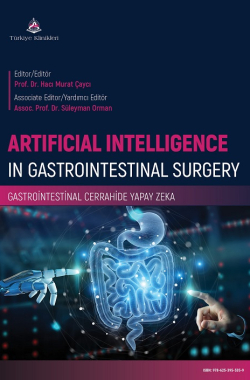ARTIFICIAL INTELLIGENCE (AI) INANORECTAL AND PELVIC DISEASES
Mehmet Ömer Özduman
Kartal Koşuyolu Yüksek İhtisas Hospital, Department of Gastroenterology Surgery, İstanbul, Türkiye
Özduman MÖ. Artificial Intelligence (AI) in Anorectal and Pelvic Diseases. Çaycı HM, ed. Artificial Intelligence (AI) in Gastrointestinal Surgery. 1st ed. Ankara: Türkiye Klinikleri; 2025. p.71-78.
ABSTRACT
Diseases related to the pelvic floor and anorectal region are frequently seen in society. However, due to variations in the anatomy of this region and the complex structure of the pelvic floor muscles and their relationship with other organs, there may be delays in diagnosis and treatment. One of the biggest innovations brought by artificial intelligence in the field of medicine is segmentation and classification, where imaging techniques are used more effectively than conventional methods. Thanks to these new algorithms, the relationship between the pelvic floor muscles and pelvic organs can be shown more clearly and with fewer errors in real time in 3D. It has been shown that a more effective evaluation can be made after the optimization of anorectal manometer used in the distinction between obstructive defecation syndrome and fecal incontinence with artificial intelligence. The effectiveness of 3D reconstruction images using artificial intelligence has been demonstrated in patients with perianal fistula in showing the fistula tract, detecting the internal opening mouth of the fistula, and confirming whether the abscess drainage was sufficient. Studies have also shown that early diagnosis of precancerous lesions in the anal canal can be made using images obtained with high-resolution anoscopes and high-resolution microendoscopes with artificial intelligence. In this context, although there are studies on artificial intelligence in the differential diagnosis and treatment of anorectal and pelvic floor diseases, it is clear that studies with larger patient numbers are needed.
Keywords: Pelvic floor; Artificial intelligence; Anorectal
Kaynak Göster
Referanslar
- Aleissa M, Osumah T, Drelichman E, Mittal V, Bhullar J. Current Status and Role of Artificial Intelligence in Anorectal Diseases and Pelvic Floor Disorders. JSLS: Journal of the Society of Laparoscopic & Robotic Surgeons. 2024;28(2):e2024. 00007. [Crossref] [PubMed] [PMC]
- Bharucha AE, Basilisco G, Malcolm A, Lee TH, Hoy MB, Scott SM, et al. Review of the indications, methods, and clinical utility of anorectal manometry and the rectal balloon expulsion test. Neurogastroenterology & Motility. 2022;34(9):e14335. [Crossref] [PubMed] [PMC]
- Levy JJ, Navas CM, Chandra JA, Christensen BC, Vaickus LJ, Curley M, et al. Video-based deep learning to detect dyssynergic defecation with 3D high-definition anorectal manometry. Digestive Diseases and Sciences. 2023;68(5):2015-22. [Crossref] [PubMed]
- Waheed KB, Shah WJ, Altaf B, Amjad M, Hameed F, Wasim S, et al. Magnetic resonance imaging findings in patients with initial manifestations of perianal fistulas. Annals of Saudi Medicine. 2020;40(1):42-8. [Crossref] [PubMed] [PMC]
- Yang J, Han S, Xu J. Deep Learning-Based Magnetic Resonance Imaging Features in Diagnosis of Perianal Abscess and Fistula Formation. Contrast media & molecular imaging. 2021;2021(1):9066128. [Crossref] [PubMed] [PMC]
- Tang H, Peng C, Zhao Y, Hu C, Dai Y, Lin C, et al. An applicability study of rapid artificial intelligence-assisted compressed sensing (ACS) in anal fistula magnetic resonance imaging. Heliyon. 2024;10(1). [Crossref] [PubMed] [PMC]
- Jeri-McFarlane S, García-Granero Á, Ochogavía-Seguí A, Pellino G, Oseira-Reigosa A, Gil-Catalan A, et al. Three-dimensional modelling as a novel interactive tool for preoperative planning for complex perianal fistulas in Crohn's disease. Colorectal Disease. 2023;25(6):1279-84. [Crossref] [PubMed]
- Bonmati E, Hu Y, Sindhwani N, Dietz HP, D'hooge J, Barratt D, et al. Automatic segmentation method of pelvic floor levator hiatus in ultrasound using a self-normalizing neural network. Journal of Medical Imaging. 2018;5(2):021206. [Crossref] [PubMed] [PMC]
- He K, Cao X, Shi Y, Nie D, Gao Y, Shen D. Pelvic organ segmentation using distinctive curve guided fully convolutional networks. IEEE transactions on medical imaging. 2018;38(2):585-95. [Crossref]
- Zhang X, Xiang Y, Yao J, Hu X, Wang Y, Liu L, et al. Automatic segmentation of the female pelvic floor muscles on MRI for pelvic floor function assessment. Quantitative Imaging in Medicine and Surgery. 2023;13(7):4181. [Crossref] [PubMed] [PMC]
- Saraiva M, Spindler L, Fathallah N, Beaussier H, Mamma C, Quesnée M, et al. Artificial intelligence and high-resolution anoscopy: automatic identification of anal squamous cell carcinoma precursors using a convolutional neural network. Techniques in Coloproctology. 2022;26(11):893-900. [Crossref] [PubMed]
- Saraiva MM, Spindler L, Fathallah N, Beaussier H, Mamma C, Quesnée M, et al. Deep Learning in High-Resolution Anoscopy: Assessing the Impact of Staining and Therapeutic Manipulation on Automated Detection of Anal Cancer Precursors. Clinical and Translational Gastroenterology. 2022:10.14309. [PMC]
- Brenes D, Kortum A, Carns J, Mutetwa T, Schwarz R, Liu Y, et al. Automated In Vivo High-Resolution Imaging to Detect Human Papillomavirus-Associated Anal Precancer in Persons Living With HIV. Clinical and translational gastroenterology. 2023;14(2):e00558. [Crossref] [PubMed] [PMC]

